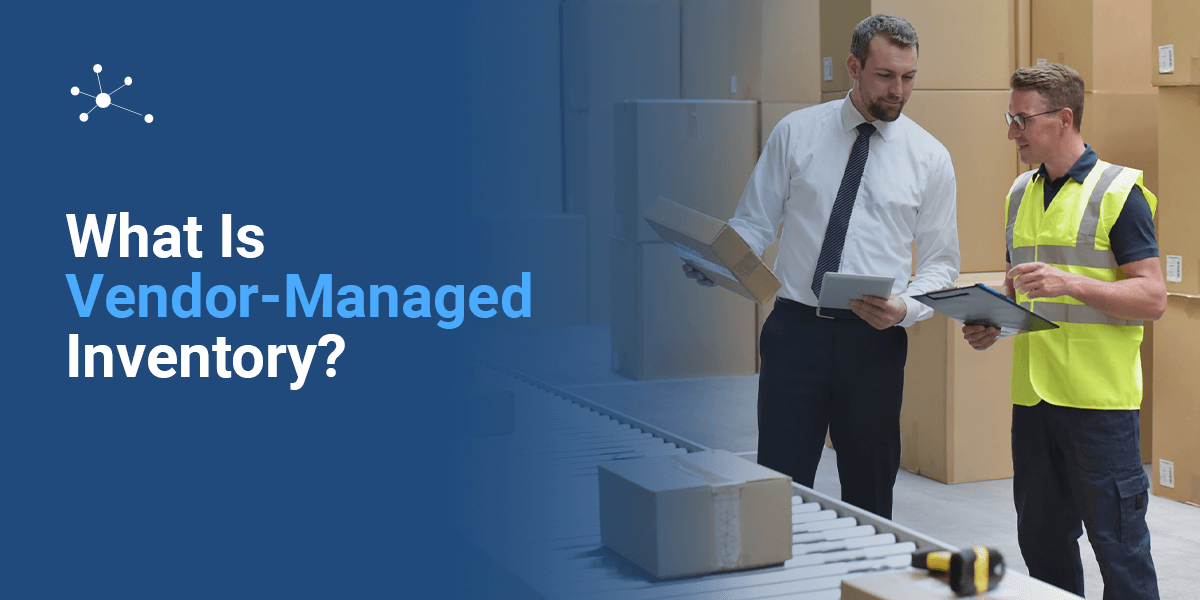
Vendor-managed inventory (VMI) is a popular process that vendors and customers can use to improve inventory management. Whether you're a customer or a supplier, you can benefit from using a VMI system. While VMI can be very advantageous, you should understand how this process works and the ways you can make it more successful before you implement it.
Find out more about what VMI is, its goals and the processes involved in it. If it sounds like an attractive option to you, you may also want to know more about its benefits, potential drawbacks and how you can successfully implement it.
What Is VMI?
VMI refers to a process where a vendor or supplier manages a client's inventory. Instead of a client managing their inventory, a VMI has the vendor be responsible for managing it.
When a client works with a vendor via a VMI, they'll have to share a great deal of information with the vendor. This data sharing allows the vendor to receive more visibility over their client's inventory. When a client runs out of goods, the vendor is responsible for resupplying them and ensuring the client always has the right number of products available for their needs.
What Are the Goals of Vendor-Managed Inventory?
The biggest goal of VMI is to ensure customers and suppliers have a beneficial relationship by accurately and efficiently controlling the flow and availability of goods.
When a customer such as a retail store turns to a VMI, they'll typically aim to lower their inventory levels at their physical stores and reduce the risk of stockout situations. A retailer will also want to use VMI to improve its inventory turnover. Other goals include bettering their customer services and reducing their overall costs, such as expenses related to holding inventory.
What Is the VMI Process?
Since VMI aims to help clients and vendors to work together, the process involves both parties sharing benefits and risks. When a client uses VMI, their vendor manages their inventory and oversees their supply chain. This responsibility to oversee and manage the client's supply chain involves material sourcing, market trend monitoring, shipping management and product delivery to warehouses or other destinations.
Since the vendor handles so much of the client's inventory and supply chain needs, the client generally only needs to worry about their product or raw material's delivery date. In this relationship, the client is responsible for paying for holding costs while the vendor pays for the client's ordering expenses. Occasionally, third-party logistics (3PL) providers play a role in the VMI process. This logistical provider will adjust supply gaps and demand to ensure the client always has the right inventory levels.
One of the primary elements of the VMI process involves shared risk. This shared risk can come in the form of a vendor repurchasing products from a client when the client doesn't sell the inventory. Another element of shared risk is when a customer houses a vendor's products but doesn't own them. Once the company makes a sale, they'll often receive a profit or commission from the exchange. By having shared risk between the vendor and customer, both parties are incentivized to succeed.
What Are the Benefits of Vendor-Managed Inventory?
Vendors and customers can both receive several VMI benefits to help them become profitable and operate more efficiently. Besides the individual advantages of VMI for customers and vendors, other factors are mutually beneficial.

Here are some of the top benefits of VMI for customers, vendors and both parties:
For Customers
When a company uses VMI, they can better avoid stockout losses, receive greater time management, lower the risk of stockouts and reduce costs:
- Better avoidance of stockout losses: By working with a vendor that has information about their inventory status, a customer can eliminate most of the uncertainty surrounding inventory levels. Since the vendor will have data allowing them to quickly restore a client's inventory when it reaches a certain point, the client doesn't have to worry about running out of their products. As a result, companies won't have to make last-minute orders or lose revenue from their own customers who wanted an out-of-stock product.
- Greater work and time management: When a company doesn't use VMI, it must perform several inventory management tasks, such as generating purchase orders and tracking reorder points. By turning to VMI, a company can use its time more efficiently by outsourcing many inventory management tasks to a vendor. Since the vendor will manage the client's inventory, the client's staff can focus on more profitable tasks, such as spending more time on marketing or improving their customer service.
- Lower risk of stockouts: When a company has to handle their inventory independently, they run a higher risk of stockouts. This higher risk comes from having to devote staff to tracking reorder points and make purchase orders, with these staff members potentially overlooking these factors while performing other work. A customer using VMI passes this responsibility to the vendor, who specializes in this sort of work. A vendor is usually better at inventory management, reducing stockout risk.
- Reduced costs: When a company relies on VMI, it can also reduce its costs. Since a vendor will handle their inventory, the customer doesn't have to devote resources to handling administrative responsibilities. By not having to train and devote staff to administrative tasks, they can reduce their expenses. Vendors can also deliver greater insights into customer behavior to companies, leading to those companies saving money by not investing in products that don't sell well.
For Vendors
Alongside the benefits for customers, VMI also provides significant advantages to vendors. Some of these benefits include greater warehouse space use, better cost reduction, increased inventory transparency and improved staff effectiveness:
- Greater warehouse space use: When a vendor controls their client's inventory, they can better understand the market demand for the products and material. This knowledge helps vendors know how they should use the space in their warehouse, stocking up on products that sell fast and reduce slow-moving products taking up precious floor space. Vendors use VMI to get much more control over their inventory, using client data to lower production expenses and avoid stocking low-selling goods.
- Better cost reduction: With VMI, a vendor can send their inventory to a customer, who will store it at no expense to the vendor. By offloading inventory from their warehouse to a customer's location, vendors can significantly cut costs related to storing products. This method of having vendors store their inventory at a customer's location can also raise client satisfaction. The client will rarely face a situation where they run out of supplies due to the constant flow of new goods and products from the vendor.
- Increased inventory transparency: One of the major advantages of VMI is the increased transparency over inventory levels. With greater inventory transparency, a vendor will have a greater understanding of product demand. The increased information VMI provides to vendors helps them avoid unexpected surges in demand for goods and better forecast what products their clients will require throughout the year.
- Improved staff usage: Since VMI gives vendors greater information on their client's supply chain, they greatly simplify many supply chain processes. This greater simplicity and the vendor's control over the supply chain enables them to better communicate with warehouse owners, customs clearance personnel, drivers and other key staff members. With improved communication, the vendor can use their staff more effectively, resulting in greater time management and increased profitability.

For Both Parties
Since VMI relies on a symbiotic relationship between customers and suppliers, it's no surprise there are a few mutual benefits VMI provides to both parties. Review the following top advantages for both parties:
- Better customer service: Vendors and clients both benefit from greater customer service when they use a VMI. In the case of vendors, they'll be more likely to handle their customers' needs quickly and deliver products when needed. Clients then pass on the greater customer service they receive to their customers, ensuring products are always available for sale. Both customers and vendors can also more easily access inventory data, allowing them to provide more accurate information during customer service interactions.
- Increased purchase order stabilization: Without VMI, customers and vendors often run into issues where purchase orders are either sent or received randomly, leading to slower order fulfillment. Since VMI can generate purchase orders at predefined intervals, neither party has to worry about miscommunications or unexpected orders.
- Reduce data entry error: A VMI connects suppliers and customers via computer to computer communications. This connection is often managed through an inventory system, where both parties can see data entries and flag potential errors. Computers and other devices used for VMI often remove the need for manual entry, leading to fewer user errors. By reducing data entry errors and the need for manual intervention, both parties also see faster order processing speeds.
- Stronger partnerships: Companies and their vendors have to work closely together when they use a VMI. This increased collaboration helps both parties establish better relationships with one another. By strengthening their partnership, a vendor and customer can achieve mutually beneficial solutions and reduce misunderstandings.
- Higher inventory ratio: Suppliers and their clients need to have a high inventory turnover ratio to compete with other companies. Since both parties collaborate to meet market demand and reduce stockouts, both parties can usually increase their inventory turnover ratio. Instead of wasting money storing products that will never sell or running into stockout issues due to high demand, VMI allows both parties to use data about the market to increase their sales.
Potential Pitfalls of VMI
While VMI has many advantages, it occasionally comes with some disadvantages and risks that customers and vendors should be aware of before using it. Some of the potential pitfalls of VMI include:
- Vendors not delivering: Sometimes, vendors can't deliver on their promises, leading to stockouts and other negative effects. When a vendor can't give customers the quality they need, provide on-time shipments or avoid mistakes, a company's profitability and customer satisfaction can decrease.
- Getting stuck with a non-effective supplier: At times, VMI systems make it hard for a company to switch vendors when their existing vendor isn't delivering effective results. Switching suppliers can disrupt a company's supply chain, causing them to experience various issues.
- Data vulnerability: Since customers have to share their data with vendors when using a VMI, their data is at a greater risk of data theft. While a rare occurrence, a non-trustworthy vendor could share confidential data with other parties. Besides malicious actions from a vendor, a vendor with ineffective data protection protocols could inadvertently lead to data loss.
How to Set up VMI Relationships for Success

Since there can be some potential pitfalls of VMIs, customers and suppliers should implement a few best practices for successful relationships. Here are our main tips for achieving an advantageous VMI model:
- Set clear expectations: Before either party enters into an agreement, they should clarify expectations and how both of them will benefit. Since the vendor may not see advantages in the short term, ensure clear communication from the very beginning. By setting clear expectations and continually communicating about inventory plans, suppliers and customers will be more likely to stay committed to the agreement and work towards gaining mutual benefits.
- Ensure you have open communication channels: Another way customers and vendors can succeed with a VMI is to set clear and open channels for communication. By having open communication channels, both companies are more likely to deal with issues and misunderstandings faster and more effectively. When issues arise, open communications channels make it more likely both parties can use them as learning opportunities and take issues to prevent problems from occurring in the future.
- Employ a standard information exchange method: When you enter a VMI agreement, you can make it more effective by employing a standard information exchange method. At ConnectPointz, we regularly provide customers and vendors with electronic data interchange (EDI) software. Our EDI software improves end-to-end automation, document exchange and in-line compliance validation. This software also comes with consolidated portals to make it easier for partners to handle large data quantities. By using this software, companies can more easily share information and make their partnership successful.
Learn More About How ConnectPointz Simplifies Vendor Relationships
At ConnectPointz, we regularly help vendors and customers simplify their relationships. Our platform helps VMI systems reach their full potential by adding transparency to more business processes and providing greater information about their inventory. Our EDI software solutions give users greater automation and document exchange, so you can expect to share information more easily with your partners and ensure all data is accurate.
If you're interested in using VMI more effectively, register for ConnectPointz today to receive a free demo. Please reach out to us if you have any questions.










































